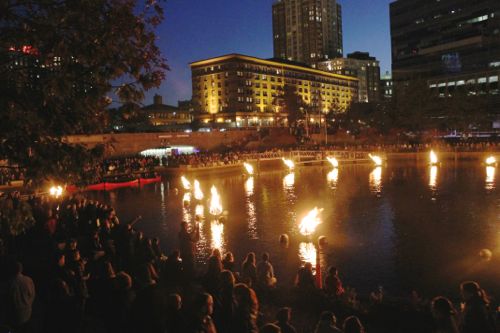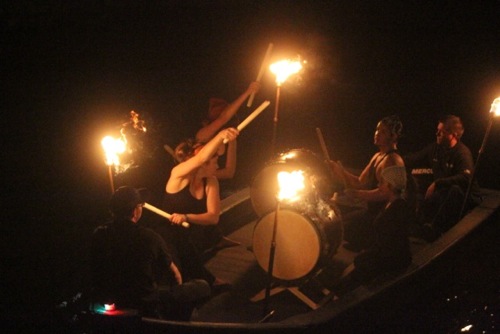WaterFire creator Barnaby Evans is in town for a series of meetings with local officials, business owners and residents to discuss efforts to bring a new WaterFire installation to the Peconic River.
WaterFire on the Peconic is taking shape and moving forward, Evans told a gathering of about two dozen supporters Monday evening at the Suffolk Theater on in Riverhead.
Thanks to the work of strategist Lisa Lowenstein over the past few months, Evans said, WaterFire has garnered the support of both Riverhead and Southampton towns as well as Suffolk County.
(Photo: Denise Civiletti)
Riverhead Town, with assistance from Lowenstein and Evans and the support of Southampton, has already applied for two substantial grants — totaling more than $2.3 million — to help underwrite the project. Both grants are very competitive, Evans said. But even if WaterFire on the Peconic does not receive the funding, the process of writing the grant applications was in itself a useful exercise that helped give form and substance to the Peconic iteration of creative placemaking proposal.
And that form and substance is nothing less than a new vision of the community itself – a “river community” surrounding and embracing the Peconic.
“We are no longer talking about Riverhead and Southampton,” Lowenstein said last night. “We’re talking about a community that knows no politically recognized jurisdiction but that embraces the river on both sides and includes Riverside and downtown Riverhead,” she said. “This community has been born.”
State, county and local officials recognize that WaterFire will have regional impact, Evans said. This collaboration is going to serve to empower this entire region to improve a whole bunch of things they’ve been working on in many other ways.”
(Photo: Denise Civiletti)
In Providence, where WaterFire has a $2.1 million annual budget and employs 23 people full-time, the installation infuses $114 million per year into the local economy, he said. WaterFire has has similar impacts on the city of Sharon, Pennsylvania, where WaterFire has been lit over the past two summers, drawing tourists and driving downtown revitalization. See prior story: “Transformation and renewal: What Riverhead can expect from WaterFire, as seen from a small town in western Pa.” (Oct. 29)
“Now is really the time to turn this into something real,” Lowenstein said, citing examples of details that need attention, including finding a source of firewood and underwriting support to purchase it, finding a building to store the installation’s equipment like the braziers used for the fires and boats used to light them.
WaterFire on the Peconic’s next step is to enter into an agreement with a fiscal sponsor — a nonprofit organization recognized by the IRS that can accept donations on behalf of WaterFire on the Peconic, Evans said. The fiscal sponsorship agreement will allow WaterFire on the Peconic to commence fundraising efforts while organizers incorporate a new nonprofit entity and apply to the IRS for tax-exempt status — a process that can take up to 14 months, Evans said.
Evans said he has already spoken with the New York Foundation for the Arts, but would rather have a local fiscal sponsor. He and Lowenstein are in discussions with a couple of nonprofit organizations regarding fiscal sponsorship, Evans said.
Lowenstein said Evans will “work to knit together the specifics of a plan” for WaterFire on the Peconic, but the entity that will actually undertake WaterFire here will be local, staffed by local people and run by a local board.
“But you want to make sure you leverage this region, including the South Fork and western Suffolk,” she said.
“It’s go big or go home,” Lowenstein said. “We don’t want this to be an expense for the community. If it’s big, it’s an investment, and it’s an investment that will generate a tremendous return on many levels — but you have to reach that critical mass,” she said.
 In short, size matters.
In short, size matters.
“We’re not interested in encouraging people to do a little experiment. This is not a little experiment,” Lowenstein said. “This is a tried-and-true approach to building vibrancy.”
Among the “stakeholders” assembled for an update were County Legislator Al Krupski, Riverhead Town Supervisor Sean Walter, Southampton Town Deputy Supervisor Frank Zappone, Riverhead Councilwoman Jodi Giglio, Suffolk County Community College Culinary Arts director David Bergen, Renaissance Downtowns planner Sean McLean and community outreach coordinator Sirri Barrios, owners or managers of several downtown businesses — Hyatt East End, L.I. Aquarium, Blue Duck Bakery, Dark Horse Restaurant, Peconic Ballet and the Suffolk Theater — and representatives of community groups like East End Arts, Peconic Land Trust and Defend H2O.
To keep up with news of the project’s status , follow WaterFire on the Peconic’s Facebook page, where information about the fiscal sponsor and initial fundraising efforts will soon be posted, she said.
The survival of local journalism depends on your support.
We are a small family-owned operation. You rely on us to stay informed, and we depend on you to make our work possible. Just a few dollars can help us continue to bring this important service to our community.
Support RiverheadLOCAL today.































